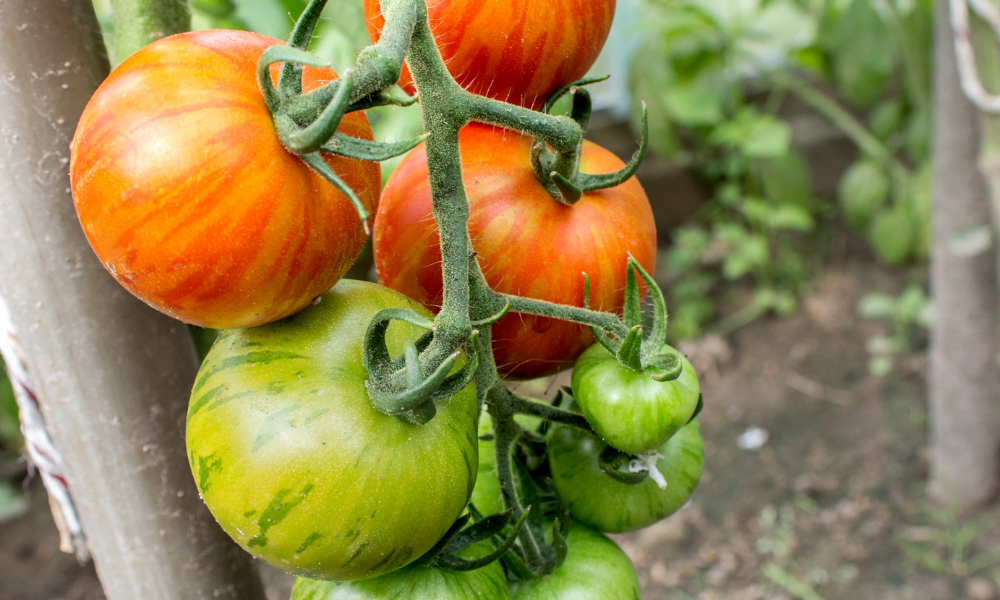Tomatoes, to me, are one of the best parts of summertime.
There’s nothing quite like cutting up a few tomatoes for a snack, or adding freshly-picked tomatoes to a slice of fluffy bread with a dollop of mayo for an easy lunch.
Enjoying your own homegrown tomatoes is easy—even for the most beginner gardeners.
However, you can’t plant your tomatoes into the ground and call it a day. Your tomato plants need support to flourish. So which method is best—cages or stakes?
Well, it depends on which tomato variety you choose.
Determinate vs. Indeterminate Tomato Varieties
Not all tomatoes grow the same.
There are two types of tomato plants: “determinate” and “indeterminate.”
Determinate tomato plants will grow to a certain height (generally between 3 – 4 feet), and then stop growing. These include your classic tomato bush varieties like Early Girl, Rutgers, San Marzano and Amelia.
Determinate tomatoes are one and done, producing fruit all at once. These make them your best tomato plant pick if you want to harvest your tomatoes at the same time, like to stock your pantry with freshly canned tomatoes.
Indeterminate tomato plants, on the other hand, know no bounds. These will grow and grow (and then grow some more), while continuing to produce fruit along its stems the entirety of the growing season. Indeterminate tomato varieties are a good option if you’re looking to enjoy fresh ‘maters’ all season long. Most tomato varieties are indeterminate, like Bradley, Cherokee Purple, Beefsteak, and Brandywine.
We grow both determinate and indeterminate varieties in our U-Pick Garden. Our hybrid varieties (Amelia, Red Deuce and San Marzano) are all determinate. We also grow these indeterminate varieties: Bradley, Yellow Pear and Sweetheart Grape.
Depending on which type of tomato plant you choose to grow—determinate or indeterminate—will determine what type of support you’ll need.
Wire Cages
Wire cages are ideal for supporting determinate tomato varieties, since they help to support the bushy weight of the fruit that develops all at once.
Look for a tomato cage that’s between 3 – 4 feet tall, and place this in the ground prior to your plants maturing to avoid injuring the root system. Secure the base of the cage about 6 inches into the soil, checking to make sure that it can’t be toppled over.
As your plant grows, intertwine the vines into the mesh cage using twine, yarn, cloth scraps, or zip ties.
You can find tomato wire cages as your local hardware store.
Wooden Stakes
Wooden stakes are great options for indeterminate tomato varieties. You can also use these for determinate varieties. Be sure to use untreated wooden, since treated wood can contain chemicals that can harm your plants.
At Stoney Creek Farm, we use wooden stakes to support our tomatoes—both determinate and indeterminate. From trial and error, we’ve found that stakes do a better job at keeping the tomato plants upright so they can produce the most fruit during the growing season. Wooden stakes also allow our U-Pick Garden customers to easily pick the fruit.
If using stakes for indeterminate tomatoes, look for stakes between 6 – 7 feet tall so there’s plenty of room for your growth-happy plants to go up ‘n up.
Determinate tomato plants, on the other hand, usually stay below 5 feet, with most growing between 3 – 4 feet high. You’re safe to use wooden stakes that are no taller than 5 feet.
Drive stakes a couple feet into the ground about 3 – 4 inches from where you intend to plant your seeds or young plants.
As your tomatoes grow, you’ll need to “train” them to grow up the stakes by tying them to the stake. Zip ties, cloth scraps, twine, or yarn all work great. We use standard twine to tie our tomatoes for our U-Pick Garden. We always burn the ties after the plants are pulled up at the end of the growing season so that no leftover blight or fungus will contaminate future plants.
Some people use rebar in place of wooden stakes. This will work, too.
ALWAYS do this.
No matter which support method you choose for your tomatoes—sanitize your cages or stakes. Always.
We sanitize our tomato stakes each year to ensure no fungus remains between planting seasons, using diluted bleach. We then let the stakes dry completely in the sun before staking any new plants. As I mentioned earlier, we also burn the twine that we use for plants, so no leftover fungus can infect future plants.
Lastly, do NOT compost your tomato plants after the growing season is over; leftover fungus can remain in the compost and spread to other plants.
Send us your tomato questions.
We love helping out fellow gardeners! Send us your tomato—or other—growing questions, and we’ll be happy to provide guidance. Email your questions to stoneycreekfarmtennessee@gmail.com.


